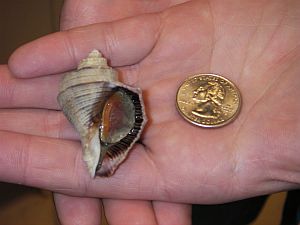The Rapa Whelk, Rapana venosa

The predatory invasive rapa whelk (Rapana venosa), originally introduced in cargo ship ballast water from the Sea of Japan into the Black Sea over 60 years ago, has possibly re-emerged as a threat to molluscan populations of the Chesapeake Bay. Tributyltin (TBT), a hazardous component of boat hull paints, caused genetic sexual abnormalities (imposex) within the whelk and was banned globally in 2008. Ironically, this mutagen, as well as a bounty on the rapa whelk until 2010, may have inhibited growth of rapa whelk populations within the Bay. Due to a possible re-emergence of this threat, the Molluscan Ecology Lab will reinstitute a bycatch monitoring program in collaboration with Dr. Michael Unger of VIMS as he compares changes in sediment TBT levels in the same area of the Hampton Roads region. This new study overlaps with the collection areas from 1998-2009 which monitored abundance, demographics and imposex status of rapa whelks. Increased density and lower imposex of collected specimens may verify that populations could quickly rebound and expand. Study information will be useful to advise watermen as well as environmental regulatory agencies regarding detection, response, emerging invasions, and how climate change may influence aquatic invasive species.

